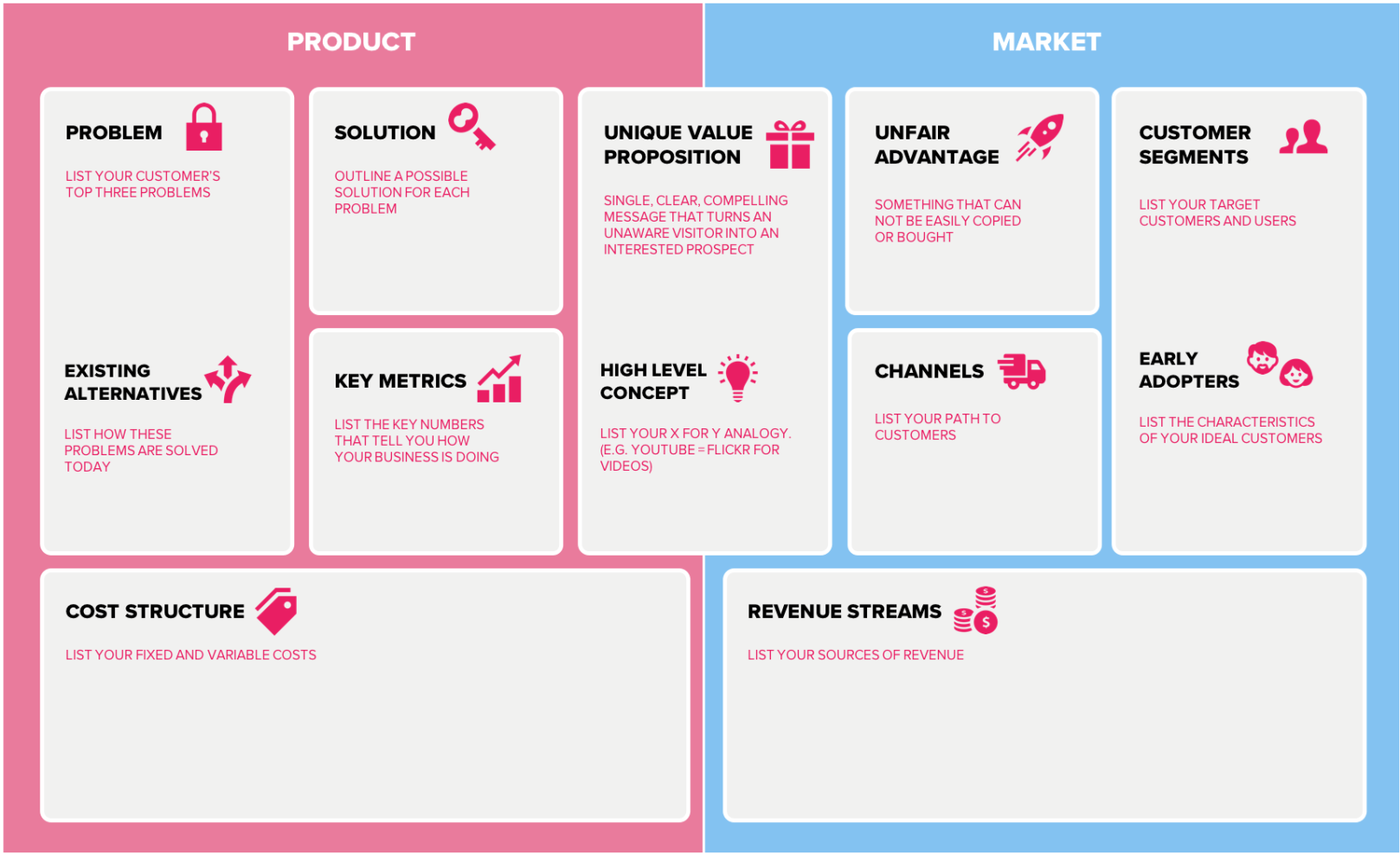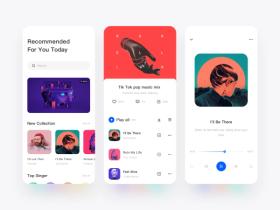Contents
How to Evaluate Your Startup Idea
Published: May 2, 2022
14 min read
In this article, you'll learn:
1
# ## ⁉️ Problem
2
👥 Customer Segments
3
📱 Solution
4
🤖 Competitors
5
🥇 Unfair Advantages
6
🏆 Unique Value Proposition (UVP) and Unique Selling Proposition (USP)
7
📢 Channels
8
💸 Revenue
9
💰 Costs
10
💡 Takeaways
Every second Startup Team dreams about the Magic 8-Ball. It’d be great to have a thing that could tell for sure whether your idea is a hero or a zero.
To find this out, or at least to get a clearer picture, you may turn not to the magic but to researching, planning and some calculations. In other words, you should evaluate your Startup business.
As a development team, we’ve witnessed other startups both fail and skyrocket. According to Failory, about 90% of startups fail due to a number of reasons. However, if we look more carefully, turns out that the thoughtful startup evaluation helps to deal with these challenges at early stages:
Top Failure Reasons* | How a startup idea evaluation could help | ||
|---|---|---|---|
🚫 No Product-Market Fit | It will be easier for you to find the Product-Market Fit if you clearly understand the Problem you’re trying to solve and how your Product helps to deal with it | ||
👥 Wrong team | You’ll be able to make up the right Team for your Startup if you distinctly see what your main challenges are and what people you need to manage them | ||
🏃♂️ Tough competition | By learning your competitors and defining your unfair advantages and a USP, you’ll have a clear picture of how your Product can be better than theirs | ||
💰 No business model | As you identify whom and how you’re helping, it’ll be much easier to turn your idea into a working business model | ||
📉 Running out of funding | After evaluating your Startup Idea, you’ll be able to clearly convey the value to Angel Investors and VCs | ||
* - according to CB Insights
What is an efficient way to evaluate a startup value? Check the step-by-step instruction below!
📖 How to Evaluate a Startup: Step-by-Step Guide
Let’s make an important stop right at the very beginning. The true purpose of why investors evaluate a startup business is to find out whether your company can grow fast.
All other questions — regarding your Product itself, Target Audience, Business Model, etc. — will either prove or disprove that your company can quickly scale.
The key idea behind startup business evaluation is figuring out whether it can grow fast

Lean Canvas for Startups (image by Upwave)
There are different evaluation techniques that help to answer this very question. Which one to choose is up for you to decide. In this guide, we’ll mostly rely on the Lean Canvas but extending it a bit with our own experience.
So how to evaluate a startup using Lean Canvas? Let’s see!
## ⁉️ Problem
The Problem itself is the most important part of your startup. Many great companies made their way to success not because they’ve offered some revolutionary technical breakthroughs but because they were first to spot and deal with the right problems.
Sometimes it may also be tempting to put a specific technology at the heart of your Product. Especially if we’re talking about new tech breakthroughs.

It may be tempting to build your Product around specific Technology but you'd better build it around a Problem (image by Igor Gedz)
Let’s think of VR or blockchain a few years ago. Remember all those blockchain companies springing up like mushrooms? That blockchain fad hit many industries from finances and healthcare to journalism and gaming.
However, many of those companies have eventually failed or, to be more accurate, haven’t raised. Unfortunately for them, the logic “Oh, I’m so excited about the blockchain, let’s use it in some project” don’t work here as you put the problem aside.
💡 Tip # 1: Don’t build your Product around specific technology, build it around a Problem.
The Problem behind your Product will also be in the focus of attention of VCs and Business Angels as they evaluate your startup company for investment.
What problems should you look for?
According to Kevin Hale from YCombinator, the perfect problem is:
- Popular — the more people face it, the better.
- Urgent — your problem needs to be solved very quickly.
- Growing — more and more people will have this problem eventually.
- Expensive — if the problem is expensive to be solved, then you can charge a lot of money for your solution.
- Mandatory — describes the problems that can’t be avoided and must be solved.
- Frequent — people face this problem again and again.
Note: The Problem at the heart of your Startup may not have all of the features from the list above. If it matches at least 2 points from this list, it may work out. However, obviously, the more attributes it has, the higher its potential is.

The right Problem is half of success (image by Gil)
We can also add one more feature to this list that is not mandatory but will definitely help you as you move on. We’re talking about your personal relation to your problem.
Do you, your family or friends face it? It’s always easier to deal with something you’ve seen from the inside. Moreover, it’ll provide you with a clearer understanding of whether your product brings real value to people who face this problem as well.
So you may count your personal relation as a little “+” in the total score list.
👥 Customer Segments
The problem goes together with people that have it. It’s good to have some personal relation to it but, as mentioned above, the problem should be popular.
We put this question at the second position since defining your audience will help you to answer further questions.

Don't try to impress everyone — focus on your most typical customers first (image by Darin Lammers)
How to evaluate your startup company from this perspective? Think of your most typical users. Don’t try to put everyone on your list of potential users, better focus on those people who are really desperate about the chosen problem. They will be your early adopters to collect feedback from and iterate your Product later.
💡 Tip # 2: Look for the most typical customers that can be easily reached.
Frequency and intensity are the key metrics when it comes to figuring out what people match the “typical user” portrait. So the customers that face the problem regularly and have an intense need to solve it are the perfect match for your Startup.
📱 Solution
This is the third crucial part of your research that will help to evaluate your startup value.
Actually, there’s not much you can do with at the evaluation stage since it’s probably just a concept, an idea of what it may be and look like. So the most important task here is not to lose this “Problem-Solution” connection.
To check whether it’s true for your Startup, do a little exercise: try to clearly state the core problem you want to solve (in 1-3 sentences) and your solution to it (also up to 3 sentences).

Make sure your Solution perfectly matches the Problem (image by Serj Marco)
Yet, at this stage, this will only be a hypothesis that can be tested only in one way — by creating an MVP and giving it to users.
Moreover, try to look for a hidden need as you come up with solutions to the chosen problem. In other words, what you definitely shouldn’t do at this stage is to ask for a solution from your potential users. People don’t know what they want until they’ve got it.
💡 Tip # 3: Look for a hidden need.
Remember Henry Ford’s saying: “If I had asked people what they wanted, they would have said faster horses”. That’s why you should look even above users’ expectations. After all, if the solution to the problem were obvious and easy to come up with, many people would be already doing that.
🤖 Competitors
When Business Angels and VCs evaluate a startup company for investment, they compare it with existing solutions trying to figure out whether it has more chances to grow.
As the saying goes: “A smart person learns from his mistakes, but a truly wise person learns from the mistakes of others”. That should be your motto as you perform competitive analysis.
How can you evaluate your startup value by looking at your competitors? Here’s a brief instruction:
- Take a look at how your audience solves the chosen problem now. These solutions will make up the list of your direct and indirect competitors.
- Analyze how these companies help to deal with the problem now and compare it to your idea. Do they offer faster horses while you’re building a car? Or do you both compete in the car market?
- Why do people use their products? What’s good about them and what makes people like it?
- What are their weaknesses? What problems and challenges have they faced?

Carefully study your competitors before launching your own Product (image by Farhan Fauzan)
Another good thing you may use at this moment is to take a look at how people are hacking the existing solutions to do something that initial developers haven’t thought of.
That’s something worth remembering as your own Product will grow, but at the competitive analysis stage, it may provide you with a clear idea of what people really need and haven’t got so far. This is something you can offer them.
💡 Tip # 4: Notice how people hack competitors’ solutions to cover the needs that weren’t satisfied so far.
Eventually, all these questions will be pushing you towards specifying your unfair advantages.
🥇 Unfair Advantages
For VCs who evaluate a startup company for investment, the growth is the key. This is the “yes/no” question. Honestly, no matter what a great impact your Product will make on humanity or what your personal traits are if they don’t see that your Startup can grow fast, they won’t probably spend much time talking to you.
💡 Tip # 5: Before pitching, come up with your Unfair Advantages — special attributes that will help your Startup grow fast.
That’s why it’s impossible to evaluate a startup business without pointing at the traits of your Product that make it competitive. Actually, it’s all about answering the question “Why is your company going to win over all your competitors? Why investor should choose you over anyone else?”.
The answer may lay in such categories:
-
🦸♂️ Founder — refers to your personal characteristics. Why are you especially qualified to solve this problem? Do you have some unique, special experience that makes you a super expert? Are you 1 of 10-20 people in the world who can deal with this task?
-
📊 Market — “good” problems are growing and so should be your market. If it grows at least 10% a year, that’s a good sign.
-
📱 Product — of course, your Product may be the unfair advantage itself. How can use measure it? It should be 10x better (faster, cheaper, etc.) than competitors’ products. It’s also good if your product is 2-3 times better but it won’t be enough for investors to consider this as your competitive advantage.
-
📢 Acquisition — how easily you can acquire new users. The perfect situation is when the acquisition cost is $0, meaning that you get new customers from word-of-mouth marketing.
-
🏆 Monopoly — is it more difficult for others to compete with your Company as you grow? This is especially true for marketplace (read “winner takes it all”) Startups like Uber, Booking.com, Glovo, Postmates, Airbnb, etc.
However, it doesn’t mean that your Startup should have all of the unfair advantages listed above. Having even 1 will be a good place to start but, obviously, the more points you score, the better.
Note: Since the Market advantage doesn’t really depend on you and may change (just remember the Bitcoin hype), it may not look earnestly for investors if it’s your only competitive characteristic.
🏆 Unique Value Proposition (UVP) and Unique Selling Proposition (USP)
How to evaluate a startup in two sentences? Define your UVP and USP. It’s the shortest way to present your competitive advantage and value to customers.
The difference between a UVP and a USP may be a bit confusing, so let’s clear things out.
The Unique Value Proposition (UVP) is all about what your customers will get from using your product. It focuses on benefits for your audience, often in an emotional, even a bit storytelling way. However, there’s no fixed template on writing UVPs so you may not limit your creativity here.

Companies usually put their UVPs upfront (image from Airbnb's website)
Startup companies often put UVPs on their landing pages as their motto:
- Airbnb: Book unique places to stay and things to do
- Uber (for drivers): Get in the driver's seat and get paid
- felyx (e-scooters renting startup): Travel through the city in a fast, affordable and sustainable way
- Asana Rebel (yoga startup): Design Your Perfect Day
Here are a few other template examples for inspiration:
Name | Template | Example | ||
|---|---|---|---|---|
Geoff Moore’s UVP Template | For [target auidence] who [need] our [product] that [benefit] | For hosts who want to rent their property, our Web and Mobile app that allows easily finding tenants | ||
Steve Blank’s XYZ | We help X do Y doing Z | We help dog owners find a dog walker by choosing from the pool of checked candidates | ||
Eric Sink’s Template | [Superlative; main benefit] [product; what is it?] [audience/industry/purpose; who should choose it?] | The fastest payment gateway for mobile eCommerce | ||
Venture Hacks’ High-Concept Pitch | [Famous industry example] of/for [your domain] | Uber for realtors | ||
The Unique Selling Proposition (USP) describes how your Product or offer is different from that of your competitors. It’s also linked to your UVP but usually delivers a more narrow, specific idea.
If the UVP tells customers what a value they will get from using your product, the USP refers to exclusive benefits you offer that your competitors don’t.
💡 Tip # 6: The UVP and USP you can describe your main value and competitive advantage to customers and investors in just a few sentences. For example, post them on your landing page or use them during an elevator pitch.
Moreover, if the UVP often addresses emotions, the USP is more about specific benefits and numbers. Thus, it helps VCs and Business Angels evaluate a startup company for investment.
Let’s take a look at a few examples:
Industry | UVP | USP |
|---|---|---|
🚕Taxi | The fastest way to move around the city | Get 10% discount on every second ride |
🍕Food Delivery | Eat your food when it’s hot | Delivery within 30 minutes — or free |
🏨Hotel Booking | Live anytime, anywhere | No booking fees, free cancelation |
📢 Channels
A good Product that no one knows about is a bad Product. Your main goal as a Startup Team is to grow fast. And it’s only possible if the number of your users grows as well. Let’s talk through a few key ideas:
- How do I get first users?
The only way to find out whether your Product really gives some value and can be helpful is by giving it to the target audience, watching how they use it and collecting their feedback.

If you know that the problem exists, you know where to find the first users as well (image by Uran Arts)
So how do you find these very first 3-5 users that have the problem you’re trying to solve with your Product?
- Remember earlier we’ve said that having some personal relation to the problem is somewhat helpful? If you, your family or friends are the people who match the portrait of your target audience, give your Product to them. Or to yourself. That’s it.
- If you know that such a problem exists but don’t have any personal relation to it, you’ve probably heard about it from other people or seen them trying to deal with it. Talk to these people since they’re the ones who may be your first users as well.
- Finally, if that’s a really urgent and popular problem, people were probably discussing the ways to solve it on social media, internet forums etc. Try looking for your early users there.
💡 Tip # 7: If you know that the problem exists, you probably know someone who has it. These people may be your very first users.
- Ok, I have the first 10 users. How can I get my next 10, 100, 1000, 100… users?
Your further marketing strategy depends on many factors, e.g. your Product, available finances and so on. The main channels to reach your customers are:
- Digital advertising campaigns
- Landing page and SEO
- Promotional offers
- Social Media
- Word-of-Mouth marketing
The good news is that if you build really great Product, you may expect a high word-of-mouth marketing rate since people will be sharing this solution with others.

The great word-of-mouth marketing is what you should aim for (image by Lily)
However, don’t dig into details on this question too much. The further growth will be your concern later when you find your Product-Market Fit and now we’re just talking about how to evaluate a startup idea.
💸 Revenue
When you evaluate a Startup business, you should keep in mind that any business is about making money. Thus, your planned revenue structure and pricing model matters a lot.
The 2 most important questions at this stage are:
- What will you ask your users to pay for? How will you generate income?
- How will they pay? For example, Airbnb at the MVP stage hasn’t had a built-in payment gateway so users had to handle this directly with hosts.
Moreover, many Startups keep making the same mistake by giving the product that will be later paid for free or with huge discounts. They’re afraid that otherwise, no one will use their Product.

Think of your possible revenue sources beforehand (image by Igor Kozak)
However, by setting the fair price from the very beggining you’re able to test whether your Product is good at all. If it really solves the Problem that is urgent/frequent/mandatory (or everything at once), they will do pay for it. Otherwise, it may be a signal that either your Product doesn’t help that well or the Problem itself isn’t that vexed.
💡 Tip # 8: Don’t make your Product free if it’s going to be paid later. This will help to test both your Product and the chosen Problem.
Discounts are another popular issue. Don’t use them to devalue your Product and sell it 50% cheaper just because you aren’t sure anyone needs it.
It’s better to use discounts to provide some additional benefits to your customers. For example, give a discount to a user when he brings a friend, makes a second order or buys your product within 10 days.
💰 Costs
Revenue comes hand in hand with spendings. For Startup idea evaluation you don’t need to make a financial plan for 10 years. It would be enough to answer the following questions:
-
What are your fixed and variable expenses?
-
How much will it cost to make a Proof of Concept? An MVP? Verify a Product-Market Fit?
-
In case you’ll be producing physical devices:
- What is the capacity of your operation (store, manufacture, sell)?
- What resources will you require? This may include equipment, vehicles, inventory etc.
- How are you going to deliver your product to customers?
- Who are your potential suppliers?
💡 Tip # 9: Estimate approximate costs that you’ll need to get started and keep yourself running for at least a year.
Moreover, to get an idea of what the PoC/MVP development costs may be, you can contact a development agency like ours. Such companies have experience in building PoCs and MVPs for Startups from different industries so they can provide you with pretty accurate estimates after asking for some details.
💡 Takeaways
Startup idea evaluation is a good starting point. It helps to better understand your idea and startup value as well as key challenges and possible pitfalls. Research you do at this stage can be later presented to investors, so you make think of the evaluation phase as a pre-pitch phase.
We also recommend watching this video from Startup School by YCombinator:
You focus here should be on 3 key elements:
Problem
Solution
Unfair Advantage
To get a clearer picture, you also should analyze your target audience, competitors, monetization model, possible development costs etc.
Need any help with your idea evaluation? Drop us a line and we’ll help you Nail your Project as well as prepare an Estimate!
Was it helpful?
Read also

Stormotion's ChatGPT Journey

Top 5 Best Practices for Integrating ChatGPT in Your App

How to Build SaaS App Like Spotify
Our clients say
![Stormotion client Pietro Saccomani, Founder from [object Object]](/static/40e913b6c17071a400d1a1c693a17319/b0e74/pietro.png)
They make the whole business work for us, and their improvements are fundamental to our operations. They’re reliable, honest, and willing to try new things that will help us. We appreciate how flexible and easygoing they are.
Pietro Saccomani, Founder
MobiLoud
